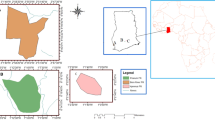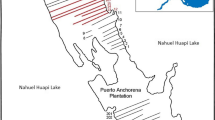Abstract
The effects of invasive species on community structure remain under-investigated due to the lack of long-term data. Our objectives were to examine the correlation between Lantana camara L. invasion and native species abundance, distribution, diversity, and population structure, across different forest types in a heterogeneous landscape. We examined changes in native vegetation and L. camara between 1997 and 2008. We used existing vegetation data from 134 plots spread across the 540 km2 landscape from 1997 and re-censused these plots in 2008. We then examined the change in species richness, Shannon’s diversity, evenness, and population structure of native species from 1997 to 2008. We also examined the relationship between L. camara density and species richness, diversity, evenness, and population structure. The presence and abundance of L. camara increased dramatically from 1997 to 2008. L. camara occurred in 81% of plots by 2008, compared with only 41% of plots in 1997. Similarly, the mean density of L. camara increased almost fourfold from 1997 to 2008. This was accompanied by a change in native community structure. Species richness, diversity and evenness declined significantly in some forest types, and at the landscape scale. There were also changes in the population structure of native tree species, with reductions in the density of tree saplings, possibly due to competition with L. camara. We demonstrate the pervasive threat posed by L. camara to native vegetation at the scale of individual forest types, and at the larger landscape scale, in our study area. These changes have long-term consequences for forest structure and composition.





Similar content being viewed by others
References
Anonymous (1942) Control of lantana in Madras. Nature 150:399–400
Anonymous (1996) Map of Karnataka soils. National Bureau of Soil Survey and Land-Use Planning, Indian Council for Agriculture Research, Nagpur
Ashton IW, Hyatt LA, Howe KM, Gurevitch J, Lerdau MT (2005) Invasive species accelerate decomposition and litter nitrogen loss in a mixed deciduous forest. Ecol Appl 15(4):1263–1272
Barve N, Kiran MC, Vanaraj G, Aravind NA, Rao D, Shaanker RU, Ganeshaiah KN, Poulsen JG (2005) Measuring and mapping threats to a wildlife sanctuary in southern India. Conserv Biol 19(1):122–130
Chytry M, Pysek P, Wild J, Pino J, Maskell LC, Vila M (2009) European map of alien plant invasions based on the quantitative assessment across habitats. Divers Distrib 15:98–107
Clavero M, Brotons L, Pons P, Sol D (2009) Prominent role of invasive species in avian biodiversity loss. Biol Conserv 142(10):2043–2049
Cronk QCB, Fuller JL (1995) Plant invaders. Chapman and Hall, London
Crooks JA (2005) Lag times and exotic species: the ecology and management of biological invasions in slow-motion. Ecoscience 12(3):316–329
Day MD, Wiley CJ, Playford J, Zalucki MP (2003) Lantana: current management status and future prospects. ACIAR monograph, vol 102. Australian Centre for International Agricultural Research, Canberra
Duggin JA, Gentle CB (1998) Experimental evidence on the importance of disturbance intensity for invasion of Lantana camara L. in dry rainforest-open forest ecotones in north-eastern NSW, Australia. For Ecol Manag 109:279–292
Ens EJ, French K (2008) Exotic woody invader prevents the recruitment of three indigenous plant species. Biol Conserv 141(2):590–595
Fensham RJ, Fairfax RJ, Cannell RJ (1994) The invasion of Lantana camara L in. Forty Mile Scrub National Park, north Queensland. Austr J Ecol 19(3):297–305
Fisher JL, Loneragan WA, Dixon K, Delaney J, Veneklaas EJ (2009) Altered vegetation structure and composition linked to fire frequency and plant invasion in a biodiverse woodland. Biol Conserv 142(10):2270–2281
Fritts TH, Rodda GH (1998) The role of introduced species in the degradation of island ecosystems: a case history of Guam. Ann Rev Ecol Syst 29(1):113–140. doi:10.1146/annurev.ecolsys.29.1.113
Funk JL, Vitousek PM (2007) Resource-use efficiency and plant invasion in low-resource systems. Nature 446(7139):1079–1081
Ganesan R, Setty RS (2004) Regeneration of amla, an important non-timber forest product from southern India. Conserv Soc 2(2):365–375
Gooden B, French K, Turner PJ (2009a) Invasion and management of a woody plant. Lantana camara L., alters vegetation diversity within wet sclerophyll forest in southeastern Australia. For Ecol Manag 257:960–967
Gooden B, French K, Turner PJ, Downey PO (2009b) Impact threshold for an alien plant invader, Lantana camara L., on native plant communities. Biol Conserv 142(11):2631–2641
Gordon DR (1998) Effects of invasive, non-indigenous plant species on ecosystem processes: lessons from Florida. Ecol Appl 8(4):975–989
Hejda M, Pysek P, Jarosik V (2009) Impact of invasive plants on the species richness, diversity and composition of invaded communities. J Ecol 97:393–403
Hillebrand H, Bennett DM, Cadotte MW (2008) Consequences of dominance: a review of evenness effects on local regional ecosystem processes. Ecology 89(6):1510–1520
Hiremath AJ, Sundaram B (2005) The fire-lantana cycle hypothesis in Indian forests. Conserv Soc 3(1):26–42
Huenneke LF, Hamburg SP, Koide R, Mooney HA, Vitousek PM (1990) Effects of soil resources on plant invasion and community structure in Californian serpentine grassland. Ecology 71(2):478–491
Iyengar AVV (1933) The problem of the lantana. Curr Sci 1:266–269
Johnson EA, Miyanishi K (2008) Testing the assumptions of chronosequences in succession. Ecol Lett 11(5):419–431
Kammathy RV, Rao AS, Rao RS (1967) A contribution towards a flora of Biligirirangan Hills. Mysore State Bull Bot Surv India 9(1–4)
Kodandapani N, Cochrane MA, Sukumar R (2004) Conservation threat of increasing fire frequencies in the Western Ghats, India. Conserv Biol 18(6):1553–1561
Landres PB, Morgan P, Swanson FJ (1999) Overview of the use of natural variability concepts in managing ecological systems. Ecol Appl 9(4):1179–1188
Litton CM, Sandquist DR, Cordell S (2006) Effects of non-native grass invasion on aboveground carbon pools and tree population structure in a tropical dry forest of Hawaii. For Ecol Manag 231:105–113
Magurran AE (1983) Ecological diversity and its measurement. Croom Helm, London
Magurran AE, Baillie SR, Buckland ST, Dick JMP, Elston DA, Scott EM, Smith RI, Somerfield PJ, Watt AD (2010) Long-term datasets in biodiversity research and monitoring: assessing change in ecological communities through time. Trends Ecol Evol
Mason TJ, French K (2008) Impacts of a woody invader vary in different vegetation communities. Divers Distribut 14(5):829–838
Melbourne BA, Cornell HV, Davies KF, Dugaw CJ, Elmendorf S, Freestone AL, Hall RJ, Harrison S, Hastings A, Holland M, Holyoak M, Lambrinos J, Moore K, Yokomizo H (2007) Invasion in a heterogeneous world: resistance, coexistence or hostile takeover? Ecol Lett 10:77–94
Mittermeier RA, Robles-Gil P, Hoffman M, Pilgrim JD, Brooks TM, Mittermeier CG, Lamoreux JL, Fonseca G (2004) Hotspots revisited: Earth’s biologically richest and most endangered terrestrial ecoregions. CEMEX, Mexico City
Murali KS, Setty RS (2001) Effect of weeds Lantana camara and Chromolaena odorata growth on the species diversity, regeneration and stem density of tree and shrub layer in BRT sanctuary. Curr Sci 80(5):675–678
Murali KS, Setty RS, Ganeshaiah KN, Shaanker RU (1998) Does forest type classification reflect spatial dynamics of vegetation? An analysis using GIS techniques. Curr Sci 75(3):220–227
Myers N (2003) Biodiversity hotspots revisited. Bioscience 53:916–917
Olden JD (2006) Biotic homogenization: a new research agenda for conservation biogeography. J Biogeograp 33:2027–2039
Pauchard A, Shea K (2006) Integrating the study of non-native plant invasions across spatial scales. Biol Invasions 8:399–413
Prasad AE (2009) Tree community change in a tropical dry forest: the role of roads and exotic plant invasion. Environ Conserv 36(03):201–207
Prasad AE (2010) Effects of an exotic plant invasion on native understory plants in a tropical dry forest. Conserv Biol 24(3):747–757
R Development Core Team (2009) R: a language and environment for statistical computing. R Foundation for Statistical Computing, Vienna
Raizada P, Sharma GP, Raghubanshi AS (2008) Ingress of lantana in dry tropical forest fragments: edge and shade effects. Curr Sci 94(2):180–182
Ramesh BR (1989) Flora of Biligirirangan Hills. Madras University, Chennai
Ranganathan CR (1934) Working plan, Kollegal forest division. In: Proceedings of the chief conservator of forests. Government of India, Madras
Sakai AK, Allendorf FW, Holt JS, Lodge DM, Molofsky J, With KA, Baughman S, Cabin RJ, Cohen JE, Ellstrand NC, McCauley DE, O’Neil P, Parker IM, Thompson JN, Weller SG (2001) The population biology of invasive species. Ann Rev Ecol Syst 32:305–332
Sanders NJ, Gotelli NJ, Heller NE, Gordon DM (2003) Community disassembly by an invasive species. Proc Natl Acad Sci 100(5):2474–2477
Sharma GP, Raghubanshi AS (2006) Tree population structure, regeneration and expected future composition at different levels of Lantana camara L. invasion in the Vindhyan tropical dry deciduous forest of India. Lyonia 11(1):27–39
Sharma GP, Raghubanshi AS, Singh JS (2005) Lantana invasion: an overview. Weed Biol Manag 5:157–165
Shigesada N, Kawasaki K, Takeda Y (1995) Modeling stratified diffusion in biological invasions. Am Nat 146:229–251
Sinha A, Bawa KS (2002) Harvesting techniques, hemiparasites, and fruit production in two non-timber forest species in South India. For Ecol Manag 168(1–3):289–300
Stinson KA, Campbell SA, Powell JR, Wolfe BE, Callaway RM, Thelen GC, Hallett SG, Prati D, Klironomos JN (2006) Invasive plant suppresses the growth of native tree seedlings by disrupting belowground mutualisms. PLoS Biol 4(5):727
Stohlgren TJ (2007) Measuring plant diversity: lessons from the field. Oxford University Press, New York
Stohlgren TJ, Chong GW, Schell LD, Rimar KA, Otsuki Y, Lee M, Kalkhan MA, Villa CA (2002) Assessing vulnerability to invasion by nonnative plant species at multiple spatial scales. Environ Manag 29(4):566–577
Strayer DL, Eviner VT, Jeschke JM, Pace ML (2006) Understanding the long-term effects of species invasions. Trends Ecol Evol 21(11):645–651
Sundaram B (2011) Patterns and processes of Lantana camara persistence in South Indian tropical dry forests. Unpublished Ph.D. thesis, Academy for Conservation Science and Sustainability studies, Ashoka Trust for Research in Ecology and the Environment, Bangalore and Manipal University
Tireman H (1916) Lantana in the forests of Coorg. Indian For 42:384–392
Totland O, Nyeko P, Bjerknes A-L, Hegland SJ, Nielsen A (2005) Does forest gap size affect population size, plant size, reproductive success and pollinator visitation in Lantana camara, a tropical invasive shrub? For Ecol Manag 215:329–338
Traveset A, Richardson DM (2006) Biological invasions as disruptors of plant reproductive mutualisms. Trends Ecol Evol 21(4):208–216
Vieira DLM, Scariot A (2006) Principles of natural regeneration of tropical dry forests for restoration. Restor Ecol 14(1):11–20
Wangen SR, Webster CR (2006) Potential for multiple lag phases during biotic invasions: reconstructing an invasion of the exotic tree Acer platanoides. J Appl Ecol 43(2):258–268
Acknowledgments
We would like to thank D. Kethe Gowda for his invaluable assistance in the field, and the staff of the Biligiri Field Station, BRT for their support. Jagdish Krishnaswamy, Gladwin Joseph, and 3 anonymous reviewers provided comments that greatly improved the quality of this manuscript. This work was funded by a grant from the International Foundation for Science, Sweden, and the Department of Science and Technology, India.
Author information
Authors and Affiliations
Corresponding author
Rights and permissions
About this article
Cite this article
Sundaram, B., Hiremath, A.J. Lantana camara invasion in a heterogeneous landscape: patterns of spread and correlation with changes in native vegetation. Biol Invasions 14, 1127–1141 (2012). https://doi.org/10.1007/s10530-011-0144-2
Received:
Accepted:
Published:
Issue Date:
DOI: https://doi.org/10.1007/s10530-011-0144-2




